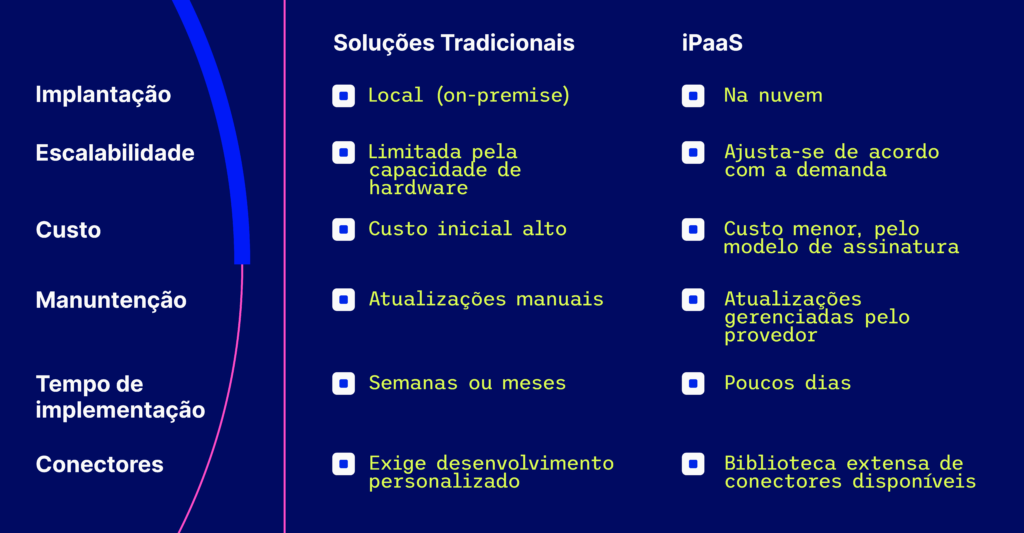In the current business scenario, the need for effective integration between systems and applications has become increasing. With market demand for increasingly specialized technologies, the big challenge is to ensure that new software , applications and resources work in an integrated manner, offering complete information in real time.
Thus, iPaaS , or integration platform as a service, has emerged as a powerful solution to this challenge, by enabling a simple and fast connection experience
cloud solution that integrates the set of platforms, functioning as a service, iPaaS has a very low cost compared to the previous market trend, which was based on the purchase of software .
The success of this type of technology is resounding, and the numbers don't lie: a study by Reportlinker predicted that the value of the iPaaS market will reach the US$13.9 billion by 2026 , registering growth of 30% per year.
So throughout this article, we'll explore what iPaaS and how this innovative technology is transforming the way companies approach systems integration in the era of cloud computing.
Discover how iPaaS not only solves traditional interoperability challenges, but also becomes a key enabler for continuous innovation and competitive advantage!
What is iPaaS?
iPaaS, or “ Integration Platform as a Service ,” is a cloud designed to facilitate the integration of different systems, applications, and data sources. It is a key technology for organizations that seek agility and efficiency in communication between their various digital tools.
By being scalable and flexible , iPaaS helps companies accelerate the digitalization of business processes, reduce IT workload and improve operational efficiency. Therefore, it is especially useful in scenarios where businesses use a mix of cloud and on-premises applications and need fast and reliable integration between them.
The use of iPaaS allows traditional integration barriers to be overcome, reducing the complexity and cost of connections between different applications. This is because the platform offers a centralized environment where multiple integrations can be developed, managed and monitored.
Thus, with its implementation, it is possible to increase the fluidity of business processes, facilitating the exchange of data in real time and improving strategic decision-making.
Furthermore, iPaaS adapts to technological changes and new market requirements. This is essential in an era where new applications and devices are constantly emerging and need to be integrated quickly and securely.
How did iPaaS come about?
iPaaS started to gain prominence in the 2000s . With the rise of SaaS ( Software as a Service), companies began to face increasing challenges in integrating dispersed cloud applications with on-premises and with each other.
The need for more agile, flexible and scalable integration led to the development of integration platform as a service solutions, which allowed the connection and automation of business processes between different applications, regardless of where they were hosted.
Over time, iPaaS has evolved to offer not only integration between applications, but also advanced capabilities such as business process orchestration, API management, data governance, and security. This evolution was driven by the continuous migration to the cloud, the increase in the volume and variety of data and the need for digital transformation in companies.
What is the difference between iPaaS and other integration solutions?
Unlike traditional integration solutions, which often require on-premises installation and maintenance of hardware and software , iPaaS simplifies integration through a more agile and flexible .
With a subscription model, initial costs are reduced, and the platform allows for easy and quick scalability, adapting to dynamic and changing business needs. Thus, maintenance and updates are managed by the provider , relieving the operational burden on companies' IT teams.
Furthermore, traditional integration solutions (often built on on-premise ) require significant investments in hardware and software , as well as a dedicated team for maintenance and updates.
These solutions are less flexible and can be more difficult to scale, requiring additional effort and expense to handle growth or changing business requirements.
While they can offer robustness and control, traditional integrations often result in a longer and more complex implementation process compared to iPaaS solutions, which promote fast and efficient systems integration with a more modern, cloud-oriented approach.
Check out a comparative table below between these two types of technology:

What is the difference between iPaaS, SaaS, PaaS and IaaS?
When we talk about iPaaS, confusion often arises about this type of technology and other similar acronyms that are also on the rise, such as SaaS, IaaS and PaaS . After all, what is the difference between them?
In practice, all these acronyms represent cloud computing services , and that is why they have this similarity between them. But to run different business processes, today, there are many as-a-service offerings available.
Therefore, when a company finally makes the final decision to opt for cloud services for the implementation and application of its infrastructure, it is essential that it understands the fundamental difference between these categories.
Now that we've seen what iPaaS , check out what the other acronyms mean below:
SaaS (Software as a Service)
software distribution model where applications are hosted by a service provider and software available to users over the internet. In SaaS, the provider manages the entire infrastructure, including servers, storage and security.
Thus, it is used to provide ready-to-use software applications, which can range from email and collaboration to CRM (Customer Relationship Management) and ERP (Enterprise Resource Planning) tools.
PaaS (Platform as a Service)
It offers an environment for developing and deploying applications in the cloud. Developers can create, run and manage applications without worrying about the underlying infrastructure.
It is mainly used by developers who want to create applications without having to worry about servers, storage, updates and maintenance.
IaaS (Infrastructure as a Service)
It is a cloud computing service model that offers computing resources over the internet. In an IaaS model, a third-party company hosts infrastructure components that would traditionally be present in an on-premises , including servers, networking hardware, storage, and the hypervisor or virtualizer.
It is often used by organizations that want to avoid the cost and complexity of purchasing and managing their own physical servers and other data center infrastructure.
How does an iPaaS work in practice?
Now that you know what an iPaaS is and how it differs from other acronyms, you need to understand how this concept applies in practice and in day-to-day business.
It is a vital technological solution for companies that need to synchronize and manage data and applications effectively. As a company grows, the complexity of its IT systems and the volume of data that needs to be processed increases exponentially.
In addition to being flexible to interconnect different systems and applications, this environment offers tools and resources to increase operational efficiency and improve data management within companies.
See below some of the functionalities of an iPaaS in practice:
Pre-built connectors and adapters
A core element of iPaaS is its pre-built connectors and adapters . Low-code platforms , which according to Gartner are expected to grow 70% by 2025 , allow quick and direct connection to a wide variety of applications and IT Systems, substantially reducing the need for custom code development. This ready-made infrastructure is key to the system's scalability, as it can easily adjust to new platforms.
Orchestration of integration processes
Integration process orchestration occurs when iPaaS coordinates and automates complex integration tasks. This orchestration is crucial to operational efficiency, enabling companies to create workflows that run without the need for manual intervention.
Centralized monitoring and management
Centralized monitoring and management makes iPaaS administration more streamlined. Through a single interface, it is possible to monitor the entire data flow , validate the performance of integrations and quickly identify any issue that requires attention. This increases the monitoring and management capabilities that iPaaS tools offer.
Security and compliance
Security and compliance are fundamental aspects of any IT system, and the iPaaS environment is no different. The platform must ensure that all data is protected and that integrations comply with current regulations. iPaaS tools take care of maintaining high security standards and facilitating compliance with laws and guidelines.
iPaaS use cases
The adoption of iPaaS platforms offers countless possibilities for companies to modernize their operations, mainly through efficient systems integration and process automation.
Thus, this technology emerges as a robust solution for connecting diverse applications in different environments, enabling optimized management of workflows and data. Below are some use cases in which iPaaS can be applied:
Integration of legacy systems with modern platforms
iPaaS platforms play a crucial role in integrating legacy systems with new applications. They create a communication channel that allows old systems still in use to communicate smoothly with more advanced technologies, maintaining business continuity and adding new functionalities without the need to completely replace existing infrastructures.
Automation of complex workflows
In automating complex workflows, iPaaS platforms stand out for allowing repetitive tasks and multifaceted processes to be orchestrated with minimal human effort . Thus, it is possible to create rules and conditions that determine how and when tasks should be performed, significantly increasing operational efficiency.
Cloud and on-premise
iPaaS is ideal for hybrid integration , where cloud and on-premises need to be connected. This form of integration supports different environments, allowing organizations to take advantage of the scalability of the cloud while maintaining certain applications on-premises, according to their security and compliance needs.
Examples of use in different market sectors
iPaaS platforms are used by companies from different sectors. HR sector onboarding processes are optimized . In marketing , enriched data campaign strategies become more agile. Other sectors, such as finance and healthcare , also benefit from the systems integration and process automation provided by iPaaS solutions, adapting their operations to the demands of the current market.
What are the main benefits of iPaaS for companies?
Integration service platforms emerge as a robust solution for companies looking to optimize their processes. It offers a set of strategic benefits , contributing to automation, cost optimization and improvements in efficiency and security.
Process automation
Companies that implement iPaaS enjoy process automation, which in turn reduces the need for manual tasks and enables more effective data management
This translates into faster, less error-prone task execution, allowing activities to be carried out in real time and patterns and trends to be immediately detected.
Cost optimization
By minimizing dependence on multiple integration softwareand the need for ongoing maintenance, iPaaS can lead to significant cost optimization.
Thus, the reduction in system integration complexity and savings on specialized technical personnel are tangible financial advantages for companies.
Productivity and scalability
With iPaaS, businesses not only gain in productivity, due to improved automation and efficiency, but also in scalability.
This is because iPaaS platforms are designed to business growth
Fast and secure integration
As we said previously, fast and secure integration between different systems and applications is possible through iPaaS.
This technology allows connections to be established with guaranteed data security compliance standards and protecting corporate and customer information.
Improved customer experience
Companies use iPaaS to improve the customer experience by integrating multiple data sources, providing a 360-degree view of the customer.
This allows for personalized service and a faster response to demands, resulting in a more efficient and effective service.
What to consider when implementing an iPaaS?
When considering implementing an integration platform as a service, companies must carefully evaluate some key aspects that will affect the security, efficiency, and success of the integration. Are they:
Data security and privacy
Security is paramount when it comes to implementing iPaaS solutions in companies. It is essential to ensure that your chosen iPaaS offers strong encryption, access controls and complies with data regulations such as GDPR and LGPD.
Therefore, to avoid future problems, it is essential that companies ensure that their iPaaS partners can protect both corporate and customer data.
Complexity in migration and integration
Migrating to an iPaaS system can be complex, involving a variety of applications and data. Therefore, companies need a detailed migration strategy that takes into account compatibility between systems, interdependencies and integration with legacy systems.
This way, a well-structured plan can reduce disruptions and simplify the transition process.
Team training and qualification
It is essential that your team is well trained to operate and manage iPaaS. Therefore, companies must invest in training programs that enable employees to take advantage of all the system's functionalities, thus ensuring effective integration.
Training is essential for iPaaS to be a transformation and optimization tool within the organization.
Cost and ROI assessment
The costs associated with implementing an iPaaS can vary. Therefore, companies must perform a detailed cost analysis , considering not only the subscription price, but also the onboarding and training costs.
Assessing return on investment (ROI) is crucial to understanding the value that iPaaS will bring in the long term. An accurate assessment takes into account improvements in operational efficiency and business agility.
How to choose the best iPaaS solution?
When looking for the ideal iPaaS solution, it is important to consider a number of criteria to ensure the platform meets your company's specific integration needs.
Therefore, the choice involves an assessment of the functionalities that each service offers and how they align with your organization's service architecture.
Below we have prepared some criteria that can help you and your company when choosing the best solution. Check out!
Rating criteria:
- Generic and specific connectors: check if the platform has a wide range of ready-made connectors that enable quick integration with different systems and applications;
- Ease of use: analyze whether the interface offers an intuitive user experience that will make integration management more agile and less complex;
- Flexibility and scalability: the platform must be able to adapt to the organization's growth, supporting a greater volume of transactions or new types of integrations;
- Security: ensuring that the platform has robust security features to protect data and communications;
- Price: consider the total cost of ownership, looking not only at the price, but also at the cost-benefit ratio that the solution offers.

Best practices in implementing iPaaS
Efficiently implementing an integration platform as a service can transform the way a company operates. Below, check out the best practices to ensure that iPaaS implementation brings the best possible results:
Strategic planning and integration roadmap
Good planning is essential. Companies must define a clear strategy and develop an integration roadmap that identifies integration needs and aligns them with business objectives. It is crucial to understand which workflows will be impacted and ensure the necessary resources are available.
- Identify key systems and necessary connectors;
- Prioritize integrations according to their impact on the business.
Stakeholder engagement
Communication and collaboration to successful implementation. Companies must involve all stakeholders, from IT staff to end users, to ensure everyone's needs are met and there is a clear understanding of the benefits of the iPaaS platform.
- Conduct regular communication meetings with stakeholders;
- Establish a channel for feedback .
Continuous testing and validation
Before putting the platform into operation, it is important to carry out a series of tests to ensure the quality and expected functionality of the integrations. Continuous testing and validation of data also helps prevent future problems.
- Implement testing cycles for each new integration and update;
- Validate integrity and process performance.
Continuous maintenance and optimization
iPaaS implementation is not a one-time project; requires maintenance and optimization . Monitoring performance, updating integrations, and adjusting workflows are critical activities to maintain operational efficiency.
- Regularly analyze the performance of integrations;
- Adjust settings to best meet changing business needs.
What to expect from iPaaS in the future?
With the continued advancement of automation and cloud technology, iPaaS solutions are adapting to offer even greater efficiency and integration between different platforms and systems.
Thus, the future holds notable transformations that will improve integration capacity, innovation and trends in the use of emerging technologies. Check out some of them:
Artificial intelligence and machine learning in integrations
AI-assisted integration will become a standard in iPaaS, deepening data analysis and automating complex workflows. Machine learning will improve the ability to predict and resolve integration issues, optimizing processes in real time.
Evolution of security
Security in cloud integration solutions will become more robust and proactive. Advances in governance and compliance will ensure that iPaaS platforms are aligned with the latest regulations, providing enhanced layers of security for organizations' sensitive and critical data.
Integration of emerging technologies (IoT, blockchain , etc.)
Integrations with IoT and blockchain will begin to stand out, offering new possibilities for automation and traceability in the supply chain. This will enable companies full potential of emerging technologies, promoting innovation and efficiency.
New developments in user experience
usability design will receive increased attention, making iPaaS platforms more accessible and intuitive. The focus on user experience will simplify integration management, allowing users without advanced technical knowledge to also operate such systems efficiently.
Create and manage your integrations with Skyone
Now that you know about iPaaS and know that the lack of integration between systems in companies is a recurring problem, it's time to count on a reliable that brings security to your business.
Skyone 's iPaaS platform is intuitive and has all the necessary elements to build and manage complex integrations for any type of system, whether cloud , local or hybrid.
Furthermore, it is a low-code that guarantees speed and simplicity in development, allowing your company to take advantage of connections already built by other developers.
Find out more about our Skyone and revolutionize the operation of your business!
Conclusion
As we have seen throughout this article, iPaaS has proven to be a valuable tool for the digital transformation of companies. With its ability to integrate several applications into a single environment, it makes it easier to obtain insights , allowing decision making based on consolidated data.
Therefore, this type of platform supports any business strategy that aims to promote greater operational efficiency on a daily basis, making systems integration faster, easier and more flexible.
Do you still have any questions about the world of integrations? Be sure to read our special on the subject!





